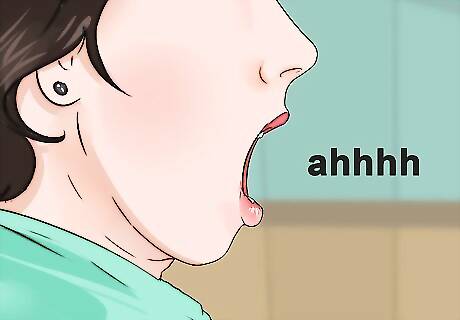
views
Improving your Singing Voice

Use your body to sing. If you feel your singing voice is awful, it is likely because you’re not using specific parts of your body correctly. When singing, stand or sit up straight. Keep your mouth slack, flexible, and loose, and exhale gently. Sing from your diaphragm to project.

Don’t push your voice. When you push your voice forcefully or strain it, your body will tighten up. This will, in turn, strain your throat muscles and you will lose much of your tone and air supply. If you're pushing your voice, it will sound out of tune or will crack and break.

Sing in-tune. Several singers struggle with proper tune and pitch. One way to perfect your pitch and tune is to play notes on the piano and imitate them with your voice. You can also use apps, like Vanido, to help perfect your pitch.

Use an instant vocal fix. If you’re really struggling with your voice, try this vocal fix. Watch your jaw move as you say “A-E-I-O-U”. Determine what vowels your jaw closes on. It is likely the vowels E and U. Try again, taking care to keep your jaw propped open. Practice singing while keeping your jaw equally open. This may take a lot of practice to perfect but will eventually become natural. Having your mouth open equally on all sounds will help keep a uniform and even voice. If you’re struggling to keep your jaw wide, wedge your fingers or a piece of cork in your mouth and try again. Practice until you no longer need the wedge to keep your mouth open.

Get natural vibrato. Vibrato is the way to change the pitch in your voice. It allows your singing to be breathy and charismatic. Knowing how to control your vibrato is a good thing, as some contemporary singers, like Ariana, have a small amount of vibrato so having control is important. Your vibrato may sound messy or feel loose and sloppy in your throat at first. Don't worry -- just keep practicing and it will become more natural and sound better over time. When you're working on your vibrato, imagine your voice spinning out of your mouth like a laser. Practice vibrato techniques. For example, stand in front of a mirror. Press on your chest with your hands then raise your chest up. Breathe in and exhale, while holding your chest steady. Sing a note and hold it as long as possible without moving your chest. Halfway through, press down with your hands but keep your chest raised to meet the pressure. Relax the back of your neck and keep your jaw open wide as you belt out the note. Imagine the air in your mouth swirling while tucking your chin slightly and keeping your chest raised.
Singing Like Ariana

Understand what makes your voice type. There are a number of variables that make up the type of voice you have. The variables that create your singing voice include range, weight, tessitura, timbre, transition points, vocal registers, speech level, and your physical characteristics. Range is determined by the notes that your body is able to produce. Weight refers to whether your voice is light and agile or heavy, rich, and powerful. Tessitura are the notes, or part of your range, that you are most comfortable singing. Timber is what makes your voice unique in terms of quality and texture. Some people may have a more gravelly voice while Ariana does not. Transition points are where you transition from singing from your chest register, to the middle, and to your head. Vocal register refers to which part of your voice you're singing in, such as head voice, chest voice, mixed voice, or whistle tone. Speech level is the range of your speaking voice. Physical characteristics play into your singing voice as some people may have larger lungs and stronger vocal cords.

Recognize that you will not be able to perfectly emulate Ariana's voice. Everyone has their own singing voice because of a number of factors so it is extremely rare to be able to reproduce someone else's voice 100%. Do not be discouraged if you do not sound exactly like Ariana. First, refine your vocal talents then you can emulate her stage presence and performance style.

Find your vocal part. Ariana is a soprano, which means she can easily sing high notes. This isn’t practical for every singer, so spend some time figuring out the highest note you can sing comfortably. It's best to work with a voice teacher or choir director to find out if you are a soprano.

Improve your high notes. To make your head voice sound richer when singing high notes, think “down”. This means if you sing high notes imagine your voice has resistance and weight. In contrast, when singing low notes in a chest voice, aim to make your voice light and airy. Add weight to your belly to keep your voice resisted. Imagine an elevator as your voice. Imagine how as the elevator rises, the counterweight must go down to get the elevator to its height.
Work on your mixed voice technique. Mixed voice is a blend between head and chest voice, and pop singers like Ariana use it frequently. It's tough to master this technique, so practice with a voice teacher for best results. Use forward placement, which you can feel resonating behind your nose and pressing forward. To figure out what this feels like, hum or imitate a siren or a baby. Press into your forward placement when taking your head voice down into your chest voice. Aim to add weight to your sound. Use lots of breath support, especially when taking your chest voice up into a mixed head voice. Thin out your tone so it sounds whinier.

Add the mechanics of a yawn. Imagine a yawn and your soft palate. Your soft palate is located at the back of the roof of your mouth. When your mouth opens to yawn, your soft palate raises. This allows you to project your voice, and sometimes, increase the tune of your vocal range.

Sing in falsetto. Falsetto singing, used by Ariana, will add character and depth to your voice. Falsetto is meant to be mostly high-pitched, in a soft, quiet voice. Imagine a 3 or 4-year-old child singing and try to emulate that with the voice you are projecting. To practice falsetto, sing to the tune of a siren or ambulance. Releasing an “ahhhh” sound to the highest note you can reach without cracking, and coming back down is a great way to practice. Another great way to practice is with the vowels “e” and “o”. These vowel pronunciations are perfect for the soft, child-like sing-song voice. Sing them from low to high pitches.




















Comments
0 comment